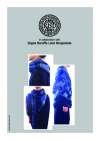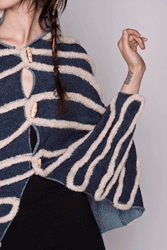
NCTO welcomes official launch of RITIN
Two dozen juniors, seniors and graduate students at Rhode Island School of Design (RSID) welcomed both the rigorous design challenge and incredible exposure to the industry afforded by a spring semester Knitted Fabrics studio taught by Assistant Professor Liz Collins, a professional artist and designer widely known for her experimental knitwear. Students in RSID’s studio partnered with Zegna Baruffa, one of the largest high-end apparel yarn companies in Italy, t

2nd July 2009
Knitting Industry
|
Rhode Island
 Two dozen juniors, seniors and graduate students at Rhode Island School of Design (RSID) welcomed both the rigorous design challenge and incredible exposure to the industry afforded by a spring semester Knitted Fabrics studio taught by Assistant Professor Liz Collins, a professional artist and designer widely known for her experimental knitwear.
Two dozen juniors, seniors and graduate students at Rhode Island School of Design (RSID) welcomed both the rigorous design challenge and incredible exposure to the industry afforded by a spring semester Knitted Fabrics studio taught by Assistant Professor Liz Collins, a professional artist and designer widely known for her experimental knitwear.
Students in RSID’s studio partnered with Zegna Baruffa, one of the largest high-end apparel yarn companies in Italy, to design and create one-of-a-kind knit garments that highlight the quality and versatility of the company’s yarns. Approximately 20-25 of the best student works produced in the studio are being exhibited at Pitti Immagine Filati, the premiere international showcase for high-end knitting yarns and knitwear design. RISD students’ work takes center stage in Zegna Baruffa’s expansive exhibition space at the trade show in Florence (July 7-9, 2009).
Zegna Baruffa is among more than 20 Italian fabric and yarn companies represented by the Italian Trade Commission, which has twice collaborated with the Textiles Department. But for this project, the company worked with RISD directly, providing luxury yarns at no cost and presenting student work to buyers from throughout the world.
In experimenting with Zegna Baruffa yarns, students were inspired by everything from famous paintings to barnacles and special Japanese bags. “The painterly yarns reminded me of Gustav Klimt’s painting Pine Forest,” notes Larissa Koeun Lee ’10 TX. So she combined three weights and tones of wool together to create the sense of contrast and depth of a cluster of pine trees. Fascinated by the barnacles that grow on the backs of whales, Lexie Newman ’10 TX designed her Barnacle Sweater to “create the feeling of barnacles growing on the surface and enveloping the wearer.” In researching indigo dyed fabrics from Japan, Ona Yopack ’10 TX discovered a type of hand-sewn bag called omiyage, or “small, handmade gift.” She translated the idea into her Omiyage Twisting Sweater, a design with “a glint of gold peeking out from the bottom” to suggest a special, hidden gift.
Since most of the students involved in the studio are Textiles (not Apparel Design) majors, Collins turned to the resources at the RISD Museum of Art to help students deal with issues of form. Curators pulled more than 20 exemplary knitwear designs from the Museum’s extensive Costume & Textiles collection and invited students to study them closely – to touch, analyze, draw, measure and generally absorb as much information as possible from these existing forms to use as inspiration and references for their own knitwear patterns.
Paola Rossi, Collins’ project partner at Zegna Baruffa, initially sent 30 cones of yarn samples, along with colour cards, so that students could experiment with various fibre weights and qualities – from fine Merino wool to chunky bouclé. Rossi’s design team at the Zegna Baruffa headquarters in Valle Mosso, Italy proscribed a palette ranging from light grey to dark blue, with 100 variations in between, which represents the colour story the company is using to market its newest yarns.
“Putting colour and material parameters on a project allows students to focus on form, construction and knit structure,” Collins explains. “When you’re forced to solve design problems within set limitations, it can actually be very liberating and lead to more expansive thinking.”
Once they had chosen a form and experimented with sample yarns, students presented their initial concept drawings, along with small knit swatches, to Rossi’s team at Zegna Baruffa. They also sent along an actual yarn order specifying the colours, qualities and quantities of each yarn they wanted to use for their projects.
While ostensibly not central to the design challenge at hand, having to order yarn proved to be an added benefit because it helped students learn some of the complexities of professional practice that are often overlooked. “You can get a wonderful education in textile design and have grounding in aesthetic and conceptual concerns, along with excellent training in technique,” she says. “But when you get out there on your own and are suddenly faced with buying these very expensive yarns from foreign suppliers, the entire selection and ordering process can be totally daunting.”
In addition to gaining professional experience, students are also benefitting from participation in one of the most high-traffic trade shows in the fashion and knitwear industries. “I am always looking for opportunities to build bridges for our department internationally, especially since many of our students want to work in the European fashion and textile industry,” Collins says. “This project is an effort toward that, as well as to get materials that are usually ‘for the trade only’ into students’ hands before they go out into the world. Zegna Baruffa understands the importance of investing in students in this manner, and are especially happy to partner with RISD since this is the first time they have ever showcased the work of students from an American art and design school.”

Business intelligence for the fibre, textiles and apparel industries: technologies, innovations, markets, investments, trade policy, sourcing, strategy...
Find out more